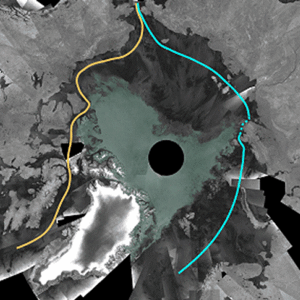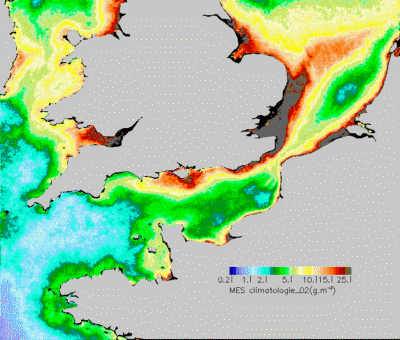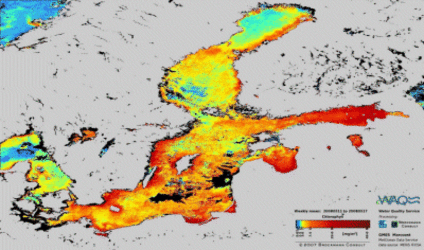Latest European Water Quality
Baltic
Brockmann Consult and DLR (both from Germany) operate a regular monitoring service for the Baltic Sea based on satellite ocean colour data. This provides daily assessments as well as weekly and monthly composites of average chlorophyll concentration and transparency. The products generated by Brockmann Consult are integrated into the German regional and national monitoring systems (eg through BSH) as well as supporting the monitoring programmes of many of the Baltic States. The latest product available shows transparency and chlorophyll concentration in the Baltic for the week of 11 – 17 May 2008

The Finnish Institute of Marine Research is also heavily involved in monitoring the Baltic environmental conditions and is responsible for the provision of key data sets to the Helsinki convention secretariat (the Helsinki convention is a treaty signed by all Baltic states to protect and manage the Baltic environment). Together with French company ACRI, FIMR make use of monthly and seasonal composites of transparency and chlorophyll concentration to monitor changes in the Baltic environment. The example product is the average monthly transparency from May to September 2007. For further details on the Helcom monitoring using ocean colour data, see the Helsinki Commission website.
Finland

The Finnish Environment Institute is responsible for Finnish monitoring activities with respect to the environmental quality of the Baltic Sea. This includes the use of both 1km and 300m resolution ocean colour data (in particular MERIS data) for generating chlorophyll concentration and transparency measurements as well as algal bloom detection and evolution forecasting. In addition to supporting national monitoring, the higher resolution products are also used for local and regional authorities such as Helsinki Municipal Environment Authority. The example product shows the latest chlorophyll concentration map for the Gulf of Finland around Helsinki and is based on MERIS 300m data.
Norway

The Nansen Centre based in Bergen have been integrating ocean colour based algal bloom detection into the national algal bloom monitoring system for over 10 years. Under the ESA GMES services activities, this information has progressively expanded to include additional water quality parameters. All information is provided to the Ministry of Fisheries as well as private sector operators (eg aquaculture managers) on request. The service includes not only a routine monitoring capability but also an evolution forecast for the larger algal blooms. The image shows the latest Algal Bloom detection map from 19 May 2008. For more examples go to:
The Nansen Environmental and Remote Sensing Centre website.
Denmark

DHI has been providing operational hydrological information to private and public sector customers both in Denmark and worldwide. Now as part of the MARCOAST project, the services have been expanded to include the integration of ocean colour derived chlorophyll and transparency data into complex models that can provide both local evolution forecasts for these parameters as well as higher level products required for ecosystem management and habitat protection. The animation shows a forecast of the evolution of chlorophyll concentration for the Danish Baltic. For access to the DHI service go to the following address and use the password “marcoast”:
Waterforecast on MarCoast website.
Germany

Brockmann Consult support the national agency, BSH, in the provision of ocean colour based products for monitoring both the North Sea and Baltic Sea areas. These include detection of algal blooms as well as monitoring of chlorophyll concentration, total suspended sediment and transparency in both regions. Prior to the availability of the Brockmann service, BSH conducted one cruise per year in the North Sea area and relied on local modelling for subsequent analyses. Recently, Brockmann improved the service to include 300m resolution information in addition to the 1km data provided previously. BSH have provided regular strong positive feedback on the routine access to daily, weekly and monthly composites of validated information products provide by Brockmann. The example shows the most recent average Suspended Sediment concentrations for the North Sea for the week 11 – 17 May 2008. For access to the service provided by Brockmann, go to:
WAQSS - Water Quality Service System
UK

Plymouth Marine Laboratory operate a web based service providing daily information products as well as weekly and monthly composites of chlorophyll concentration, yellow substance, turbidity and suspended particulate matter for all UK and Irish waters. In addition, these data are integrated into regional ecosystem models operated by national partners such as the UK Meteorological office covering areas such as the North Sea. Users for PML products include CEFAS and the UK Environment Agency, the Scottish Environment Protection Agency and the Irish Environmental Protection Agency
France

Ifremer provides two classes of service based on satellite ocean colour data:
General support to regional and national environmental monitoring and fish stock assessments through the provision of a range of data streams including mineral concentration, total suspended sediment, transparency, chlorophyll concentration and temperature. Detection of algal blooms is also provided
- Routine monitoring to support regional and national Water Framework Directive assessments. The main parameter used as a proxy for eutrophication is chlorophyll concentration based on the integration of MERIS, MODIS and SeaWiFS data. At present, the advantages of 300m MERIS data for monitoring the inshore waters addressed by the Directive is being investigated.
The example shows the evolution of monthly average chlorophyll concentrations
Italy

Daily measurements of chlorophyll concentrations and transparency are provided by Planetek to APAT for the Adriatic and Tyrrhenian Seas. In addition, weekly and monthly average composites are provided together with the 90th percentile chlorophyll concentration to support water framework directive reporting requirements for Italian waters. This service has been running since late 2005, initially providing 1km resolution products for the Adriatic and progressively expanding to cover all Italian waters at both 1km and 300m resolution. The example shows the Chlorophyll concentration between Sardinia and the Italian mainland for 15 May 2008.
Romania

Ocean Colour based chlorophyll concentration and total suspended matter are providing by the MARCOAST project (GeoID) to the Romanian Marine Research Institute, designated as responsible for monitoring Romanian coastal waters on behalf of the National Ministry of Environment and Water Management. The following benefits are cited by the Romanian Marine Research Institute:
- More frequent monitoring of water quality parameters. We get more observations and indications about water quality parameter than using only an in-situ system.
- Spatial monitoring of water quality parameters. We get observations for the full territory of the Romanian waters and beyond (complete Black Sea).
It can also support our monitoring obligations for the Ministry of Environment and the European Union (WFD). If it would be adopted operationally it will work as a complement providing information we currently do not have from our in-situ monitoring campaigns. The animation shows the evolution of total suspended matter in the Black Sea for the first week of May, 2008.







